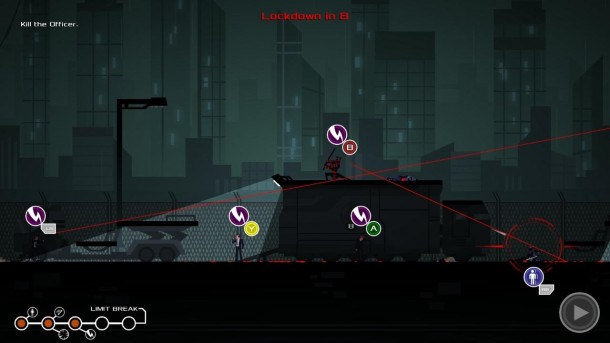Ronin Review
Ronin is a stealthy, cyberpunk-themed action platformer starring an assassin with an axe to grind. Taking some cues from Kill Bill, slick tracksuit and motorcycle helmet included, you infiltrate enemy compounds to pinpoint the location of five targets who left a stain on your past. Marred only a little by control flubs, Ronin is a brief but entertaining ride, packed full of gripping covert infiltrations and plenty of bloodshed.
As video games have often taught, it is a lot of fun to play as a lithe assassin, and Ronin is no exception. Here, you clamber up walls and dive through windows; you stick to the shadows, dodging traps and enemy eyesight; you crawl on ceilings, swing from a grappling hook, and slide down ventilation shafts--all the while sinking your sword into anyone who stands between you and your goals. The locomotion of your vengeful assassin is intuitive and fun. Hopping over platforms and rooftops is smooth, and ending your brisk sprint by bursting through a glass pane to knock down a dumbfounded security guard and plunge a katana into his back is a sinister thrill that never gets old.
But as fancy as your moves may be, it takes only one bullet for enemies to end your violent jaunt--so, naturally, you need to kill them first. Ronin employs a turn-based combat system, which makes for a rather dramatic gear shift from the methodically paced sleuthing. However, the combat is steady and challenging, and is a joy to boot. The game pauses the moment you enter battle, which offers a chance to scan the area and get your bearings on the fight ahead. Enemies train their laser sights on you, forcing you into a situation where you must escape harm. Using your mouse or analogue stick, you create a jumping arc line to evade incoming fire indicated by a red laser sight. Leaping into a guard knocks him over, which momentarily stuns him, occasionally giving you the chance to deal a finishing blow. Every action moves the battle forward one second, which is important to note, as enemies can call in lockdowns unless you can stop them within a 10-second time limit.
You have access to all of your abilities while in combat, and your mastery of them can mean the difference between a successful dodge and getting blown to bits. The tense battles have you swinging through the air on your grappling hook or bouncing from wall to ceiling like Spider-Man. Knocking down or killing an opponent earns a point that goes into a handful of unlockable skills. After collecting enough unused points, you're granted a limit break, or one free move to use however you wish, from leaping to quickly finishing off a nearby enemy.
Unfortunately, the controls aren't always as sharp as your helmeted assassin's blade.

Completing all objectives in a mission earns you a point to put toward even more skills to be added to your arsenal of moves. As your move set evolves, you're soon able to stun multiple targets, drop a distracting hologram, or perform a stealth kill (the latter being a personal favorite). The animation for the kill--basically a black rope that reaches down to pull an enemy into the rafters--does admittedly look odd. But nothing offers the same level of grim satisfaction as sneaking into a room of hapless foes and leaving meaty piñatas behind.
Unfortunately, the controls aren't always as sharp as your helmeted assassin's blade. At times, your character doesn't follow the jumping arc. It's rare, but it occurs enough to be an irritation--such as during moments when instead of leaping in an arc that leaves you a foot off the ground, the assassin jumps into the air and catches a bullet in the brainpan. For the lack of a better term, it's wobbly: controls work fine most of the time, but suddenly something shifts and you eat a bullet sandwich. Luckily, checkpoints are scattered throughout each mission, which keeps frustration to a minimum.


Worse, however, and far more aggravating, are the mistakes made due to button prompts that change depending on the situation. For example, one button is typically used in order to enter doors, but the given prompt sometimes changes if you're near someone, such as a civilian--whom you typically try not to kill. So, after getting it stuck in your head that a certain prompt is used for entering a door, you may feel a tad perplexed as to why your assassin is suddenly dealing a death blow to a civilian standing just off to the side.
This happens because Ronin allows for multiple button prompts to enable you to tackle many enemies at once while in combat. During exploration, typically only one particular button is used. But when there is suddenly another possible target, the button might swap with another (for example, from A to B), sometimes allowing the aforementioned unfortunate situation to occur. It can happen in combat as well; an accidently thrown sword will quickly teach you to take battles more slowly and stay mindful of the button prompts. It isn't a damning problem, but it is jarring, and can often lead you to reload your last checkpoint.
Minor control issues don't keep Ronin down. Though the game can be finished in around six hours, it provides enough intense moments to keep your attention locked through every second. There is also a new-game-plus mode if you're hungry for more and looking for some tougher action. Enjoyable and captivating, Ronin proves that revenge is a dish best served cold--and sometimes hanging from the ceiling.









